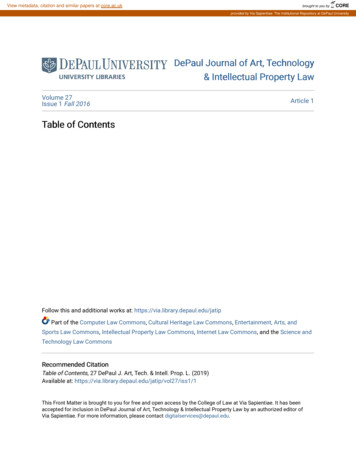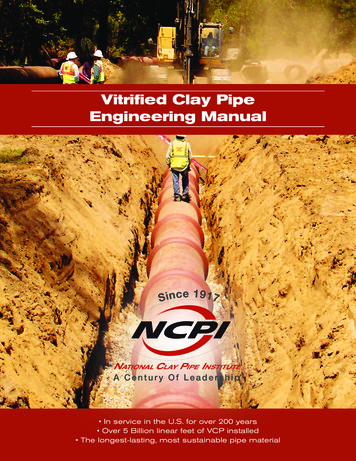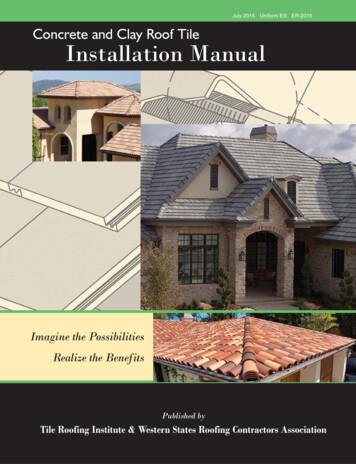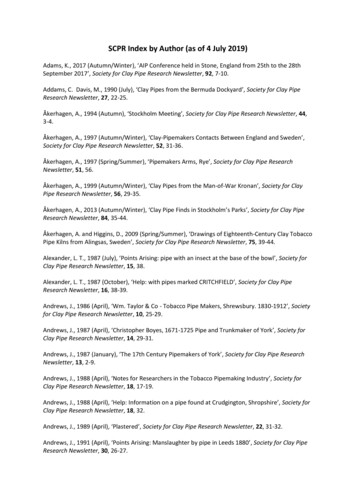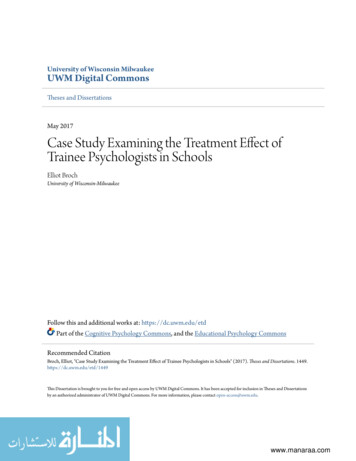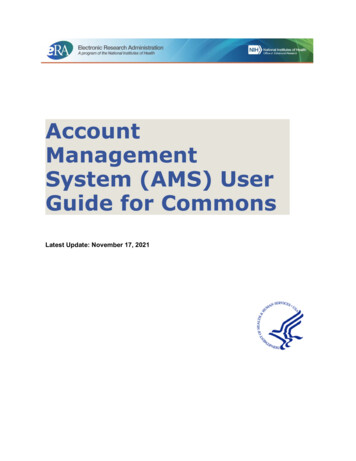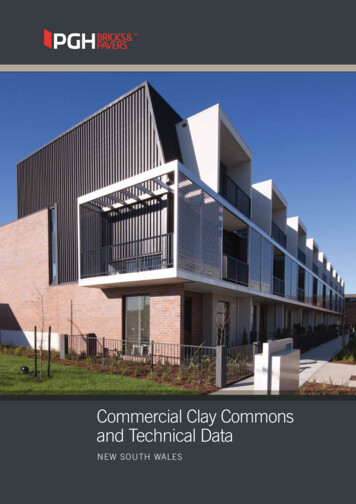
Transcription
Commercial Clay Commonsand Technical DataNEW SOUTH WALES
1
PGH BRICKS & PAVERS – COMMERCIAL CLAY COMMONS AND TECHNICAL DATATABLE OF CONTENTSClay Commons Product Summary3, 4Design & Energy Efficiency with BrickPrinciples of passive solar design55 Clay bricks outperform their lightweightcounterparts6 Clay bricks provide superiorthermal control6Strength of Brickwork7Compressive strength7Unconfined compressive strength7 Characteristic unconfined compressivestrength (F’uc)7Fire Resistance8Sound Transmission9Measurement of acoustic performance9Evaluating acoustic performance9Interpreting a sound result?10The difference between Rw and Stc?10 How to achieve the required acousticperformance10Recommended PGH solutions11, 12 Features and benefits of solidconstruction13 Features and benefits of compositewalling systems142
PGH BRICKS & PAVERS – COMMERCIAL CLAY COMMONS AND TECHNICAL DATACLAY COMMONSPRODUCT SUMMARYSTANDARD COMMONSCECIL monExposureGradeUniversalCommon19421*21504 87109*82394 87110*81508 112184*112183*20180 132753*132754 38196*79537 119728Cecil ParkCecil ParkCecil ParkCecil ParkCecil ParkCecil ParkCecil ParkWorking SizeLxWxH 10x119230x110x76230x110x76Pack Quantity336* per pallet470 per pallet336* per pallet470 per pallet336* per pallet470 per pallet196* per pallet224* per pallet310 per pallet196* per pallet224* per pallet336* per pallet470 per pallet336* per palletAverage Weight per Unit (kg)2.72.72.74.34.32.72.7Bricks per square PGPEXP 30% 30% 30% 30% 30% 30% 30%Average UnconfinedCompressive Strength (MPa)20202020202020Characteristic UnconfinedCompressive Strength(MPa f’uc) 15 15 15 20 20 15 171.6171.6176.4176.4ApplicationLoad-bearing– bagged walls,footings, piersLoad-bearing– rendered wallsLoad-bearing– Morokatype coatings,bagged walls,footings, piersLoad-bearing– rendered orbagged walls,footings, piersLoad-bearing– rendered orbagged walls,footings, piersin coastalor salineenvironmentsLoad-bearing– Moroka typecoated onbagged walls,footings, piersLoad-bearing– Moroka- typecoated onbagged walls,footings, piersin coastalor salineenvironmentsFinishWirecut1 face1 headerScratched1 face1 headerSmooth1 face2 headersWirecut1 face2 headersWirecut1 face2 headersSmooth/Wirecut1 face1 headerSmooth/Wirecut1 face1 headerFactoryDimensional CategorySalt AttackResistance CategoryVoid VolumeFRL UnrenderedFRL RenderedWall Density (kg/m²)FRLs shown in the table are test results where the structural adequacy is specific to a 3 metre high wall restrained on all 4 sides.The design of fire rated walls should be checked by a qualified structural engineer. All specifications are nominal.* Available from Cecil Park Confirm availability from Cecil Park3
PGH BRICKS & PAVERS – COMMERCIAL CLAY COMMONS AND TECHNICAL DATAAs one of Australia’s largest and most innovative brick manufacturers, PGH Bricks & Pavers offers a wide range of commons to meet your design and construction needs.STANDARD IGH PERFORMANCE COMMONSSCHOFIELDSExposureUltra CommonGrade UniversalCommonUltraSchoonerUltra Barrier 76 Ultra 6230x110x119230x140x76230x140x119225 strapped380 strapped380 strapped380 strapped230 strapped280 strapped165 DW1DW1DW1DW1DW1EXPGPEXPGPGPGPGP 30% 30% 30% 25% 25% 16% 16%25252530304040 20 20 20 25 25 30 .25159.25186.2178.2240.1247.5Load-bearing– rendered wallsLoad-bearing– bagged orpainted wallsLoad-bearing– rendered orpainted walls incoastal or salineenvironmentsHigh strength loadbearing – renderedinternal wallsdividing habitableto common areasHigh strength loadbearing– renderedinternal wallsdividing habitableto common areasHigh strength loadbearing – renderedinternal wallsdividing dry-to-dryand wet-to-wetareasHigh strength loadbearing – renderedinternal wallsdividing dry-to-dryand wet-to-wetareasWirecut2 faces2 headersSmooth/Wirecut1 face1 headerSmooth/Wirecut1 face1 headerWirecut2 faces2 headersWirecut2 faces2 headersWirecut2 faces2 headersWirecut2 faces2 headersPGH Bricks & Pavers reserve the right to change specifications without notice. Check our website for the most up-to-date result.Product testing is carried out in our PGH NATA accredited laboratory (accredited to AS/NZS 4455 & AS/NZS 4456) and by the CSIROand other independent NATA accredited laboratories.Salt Attack Resistance CategoryEXP – Exposure Grade BricksGP – General Purpose Bricks4
PGH BRICKS & PAVERS – COMMERCIAL CLAY COMMONS AND TECHNICAL DATADESIGN & ENERGY EFFICIENCYWITH BRICKBricks are an essential part of energy efficient buildingdesign. The key reason for this, is that bricks providethermal mass when used in a building. This thermalmass is a key part of passive design, a proven method ofkeeping your home at a comfortable temperature all yearround and reducing the need for heating and coolingdevices, which in turn decreases electricity loads,providing cost savings.According to the Department of Climate Change andEnergy Efficiency, “Thermal mass acts as a thermalbattery. During summer, it absorbs heat, keepingthe house comfortable. In winter, the same thermalmass can store the heat from the sun or heaters torelease it at night, helping the home stay warm.”1Principles of passive solar designBrickwork can be very energy efficient. When designing a house to be cool in summer and warm in winter, the wallmaterial as well as other factors need to be taken into account. There are five key passive design features:Orientation:Thermal Mass:Placement of the house in relation to the sun.Heavy-weight wall materials slow the passage ofheat through a wall, a process called ‘thermal lag’.And, the easiest way to get this heavy mass intowalls is by using brickwork. The heavier the brick,the higher its thermal value.Insulation:A wall’s ability to isolate temperature.Climate:The maximum day-time and minimum night-timetemperatures (diurnal range). Thermal mass ismost appropriate in climates with a large diurnaltemperature range.Tailoring these passive design features to each climateis important. Think Brick Australia has put togethera Climate Design Wizard that provides sustainabledesign strategies for designing ecologically sustainablebuildings for the unique climatic conditions withinAustralia.5Ventilation:Air flow through the house.With many new building products entering the market,it’s important to consider what will be best for thelong term sustainability of building designs and theenvironment and what will minimise energy usage afterinstallation.
PGH BRICKS & PAVERS – COMMERCIAL CLAY COMMONS AND TECHNICAL DATAClay bricks outperform their lightweight counterpartsThe thermal research findings concluded that thelightweight building was the worst performing in allseasons, brick veneer performed better than lightweightmaterials and insulated cavity brick performed the best.It also showed that the R-value is not the sole predictorof thermal performance and that there is no correlationbetween the R-value of a wall and energy usage. (R-value:is a measure of thermal resistance used in the building andconstruction industry.)to maintain the temperature in the comfort zone. Thisdata shows a clear difference between clay bricksand lightweight products with insulated cavity brickperforming the best in relation to energy efficiency in atemperate climate.180160ENERGY CONSUMPTION (MJ)In Australia, a significant proportion of the end energyusage in residential buildings is used for spaceheating and cooling.2 Research findings from an eightyear thermal research program on masonry housing,conducted by Think Brick Australia in conjunction withthe Faculty of Engineering and the Built Environmentat the University of Newcastle, found that clay bricksoutperformed their lightweight counterparts in relationto thermal performance, providing superior, energyefficient environments for people to live, work and playin.3140Total energy consumption, October ty BrickInsulated Cavity BrickInsulated Brick VeneerInsulated Lightweight Module12010080604020The graph right shows that the insulated lightweightmodule (R 1.51), with over three times the R-value ofcavity brick (R 0.44), used over three times the energy0CB (R 0.44)InsCB (R 1.30)InsBV (R 1.58)InsLW (R 1.51)Clay bricks provide superiorthermal controlThe graph right shows that the lightweight module respondsdirectly to the external environment with a rapid increaseand reduction in temperature due to its low thermal mass,unlike insulated cavity brick. The lightweight moduleexhibited no properties with the potential to assist inmaintaining adequate thermal comfort. Clay bricks havealways been known for their thermal comfort propertiesand this research confirms this.External and internal air temperatures for lightweightand insulated cavity brick modules, January 2006.350EXTERNAL AIR45TEMPERATURE ( C)This research also found that insulated lightweightbuildings exhibit greater variations in internaltemperature and minimal thermal lag, resulting in dailytemperature swings of more than twice that of insulatedcavity brick dwellings during hot conditions.3LIGHTWEIGHT MODULEINTERNAL AIR4035302520CAVITY BRICK WITH INSULATIONMODULE INTERNAL 01/06TIME (DAYS)References:1. www.yourhome.gov.au/technical/pdf/TechManual 4th edition2011.pdf (pg.114)2. Australian Residential Building Sector Greenhouse Gas Emissions 1990–2010, Australian Greenhouse Office, 1999.3. ‘Energy Efficiency and the Environment – The Case for Clay Brick – Edition 4’, Research conducted by Think Brick Australia in conjunctionwith the Faculty of Engineering and the Built Environment at the University of Newcastle, 2009. A Study of the Thermal Performance ofAustralian Housing is the full ng-brick-and-the-environment602/01/0603/01/06
PGH BRICKS & PAVERS – COMMERCIAL CLAY COMMONS AND TECHNICAL DATASTRENGTH OF BRICKWORKBrick strength is defined as resistance to load per unit area and is expressed inmegapascals (MPa). PGH offers a range of bricks that comply with strengthrequirements to optimise project, structural and cost performance.Compressive StrengthIt is measured according to AS4456.4 – DeterminingCompressive Strength of Masonry Units. Individuallycrushing 10 bricks gives the compressive strength ofeach brick and the mean compressive strength of the lot.Whilst these figures are not used in masonry design, theyare used to calculate Unconfined Compressive Strength.Unconfined Compressive StrengthUnconfined compressive strength is a calculated numberbased on the compressive strength. The test methodinvolves subjecting the individual unit to increasing loadby compressing it between two metal platens, which isthen multiplied by a factor depending on the height ofthe brick. The resulting number is called the unconfinedcompressive strength and reflects the performanceof the brick in a wall. Whilst this figure is not used inmasonry design, it is used to calculate CharacteristicUnconfined Compressive Strength.Characteristic Unconfined CompressiveStrength (f’uc)A batch of bricks has a range of strengths that wouldusually follow a normal distribution and whichcontribute to the strength of the entire wall. Importantly,the weakest brick does not determine the strength of thewall. To ensure the safe strength of the wall, engineersuse characteristic unconfined compressive strength indesign masonry calculations. This is the strength 95%of the bricks will exceed and is typically 0.86 times thelowest unconfined compressive strength found whenmeasuring the compressive strengths of the individual10 units.7PGH Bricks & Pavers provides Characteristic UnconfinedCompressive Strength details for Technical Specifications(see www.pghbricks.com.au).The design characteristic compressive strength ofmasonry (f’m as denoted by AS3700) in a wall isgenerally a function of the height of the structure andthe spacing of the load-bearing elements (the walls).Everything else being equal, the taller the structure andthe larger the spacing between walls, the greater thecompressive strength required.The compressive strength requirements also vary fordifferent levels within the same structure. Whilst thewalls on the ground floor must bear the load of all thefloors above plus the roof, the walls on the top floor mustonly carry the load of the roof itself.PGH have specific brick series’ to meet strengthrequirements as follows: f’15 Series – characteristic unconfinedcompressive strength of 15MPa is generallysuitable for load-bearing walls carrying up to3 floors. f’20 Series – characteristic unconfinedcompressive strength of 20MPa is generallysuitable for ground level load-bearing wallscarrying 4 floors. Ultra Series – characteristic unconfinedcompressive strength of 30MPa is generallysuitable for load-bearing walls carrying up to6 floors.For example: A 5-storey building with the same footprintfor each floor may use the PGH Ultra series for thefirst and second floor and the PGH f’15 series for theremaining levels (assuming the acoustic requirementsare still satisfied).
PGH BRICKS & PAVERS – COMMERCIAL CLAY COMMONS AND TECHNICAL DATAFIRE RESISTANCEFire resistance levels (FRLs) are specified in the Building Code of Australia (BCA).This system provides an accurate method of predicting the ability of a wall tomaintain its strength in a fire and to resist the spread of the fire. The FRL specifiesthe fire resistance periods (FRP) for structural adequacy, integrity and insulation.There are three components to fire resistance levelswhich are expressed in minutes.1. Structural Adequacy: the ability of a wall tocontinue to perform its structural function for thefire resistance period (FRP).2. Integrity: the ability of a wall to maintain itscontinuity and prevent the passage of flames andhot gases through cracks in the wall during theFRP.3. Insulation: the ability of the wall to providesufficient insulation such that the side of the wallaway from the fire does not exceed a pre–definedtemperature during the rated period. At thistemperature (a rise of 140 C over the ambienttemperature or a maximum of 180 C) surfacefinishes and furnishings in contact with or nearthe wall may combust.A fire resistance level is therefore expressed as a triplerating, for example 90/90/90, for each of the structuraladequacy, integrity and insulation componentsrespectively.FRLs can be determined from AS 3700 (MasonryStructures) or by testing in accordance with AS1530.4.The FRL of a wall depends not only on the thicknessof the wall, but also on its height, length and boundaryconditions (ie how it is connected to other buildingelements).For further information on Fire Resistance Levels for claybrick walls in accordance with AS 3700, refer to Manual5 published by the CBPI (www.thinkbrick.com.au).8
PGH BRICKS & PAVERS – COMMERCIAL CLAY COMMONS AND TECHNICAL DATASOUND TRANSMISSIONWith advances in technology (particularly home theatre systems) and consumer’sgrowing demand for peace and harmony, as well as listening pleasure, the needfor wall and floor systems offering superior acoustic insulation has grown.In response to the market, the Building Code of Australia(BCA) sound provisions were amended on the 1st May2004. Amendments to the BCA apply to New SouthWales, the ACT, Tasmania and South Australia. The BCAsound provisions apply to attached Class 1 buildingsplus Class 2, 3 and 9c buildings.Class 1 buildings: Buildings include singledwellings that do not have another dwelling aboveor below it, such as a stand-alone house or a rowof townhouses.Class 2 buildings: Buildings include buildingsthat contain two or more sole-occupancy units,such as an apartment unit.Class 3 buildings: Buildings include residentialbuildings that contain a number of unrelatedpersons, such as a guest house or the residentialpart of a school, hotel, etc.Class 9c buildings: A building of a public nature,specifically an Aged Care building.There are two types of correction factors:Ctr weighted towards low frequency soundssuch as traffic, trains, hi-fi systems with subwoofers. These noise sources are much moredistinct and irritating.C weighted towards general domestic soundssuch as speech, vacuum cleaners, normaltelevision and radio. The reference spectrum forthis is fairly flat and is commonly referred to as“pink noise”.The BCA often specifies in terms of Rw Ctr, whereCtr is a correction factor for low to medium frequencynoise. Therefore, the correction factor is used to showhow effective a particular wall construction is againstthose types of noise. The correction factors are negativenumbers, so the smaller the number the better. A smallnumber (eg -1) shows that the construction does nothave a large performance drop in that sound frequencyrange.Measurement of Acoustic PerformanceSound or acoustic performance is measured by theweighted sound reduction index (Rw). Rw is a singlenumber rating of the sound reduction through a wall orother building element. Since the sound reduction maybe different at different frequencies, test measurementsare subjected to a standard procedure that yields asingle number that is about equal to the average soundreduction in the middle of the human hearing range.Since the human ear does not discern all frequenciesin the spectrum, measurement standards have beenaltered to incorporate correction factors. Correctionfactors are also used to take into account common noisesources.9Evaluating Acoustic PerformanceWhen evaluating the loudness of a sound resulting onthe other side (receiver side) of a partition the followingprocess is used:1. Begin with a reference spectrum (sound source)– loudness measured in dBA2. Apply (subtract) the transmission loss of thepartition3. Determine the new dBA value on the resultant(receiver) side. The difference between thereference and the resultant values is equivalent tothe Rw Ctr (when the Ctr spectrum is applied asthe sound source).
PGH BRICKS & PAVERS – COMMERCIAL CLAY COMMONS AND TECHNICAL DATAThe frequencies considered in the Ctr spectrum havegreater levels of energy and are much more difficultto attenuate. Consequently, the BCA has adopted thisterm when specifying the minimum sound insulationrequirements involving habitable areas.Interpreting a sound result?An acoustic performance result is expressed in terms ofRw and the correction factors.For example, a wall might have Rw(C,Ctr) of 55(-1,-5),which means that Rw is 55, C is -1 and Ctr is -5. TheBCA often specifies the Rw Ctr. For this wall the Rw Ctr will be 55 (-5) or 55 - 5. So the Rw Ctr is 50.The difference between Rw and STC?Sound transmission class (STC) was a former referenceto sound performance requirements which were basedon different criteria to that of Rw ratings, and it did notinclude any correction factors. STC is no longer relevantto sound performance and cannot be used.How to achieve the required acousticperformanceThe sound performance requirements of the BCA canbe satisfied by: Building a deemed-to-satisfy wall as specified inthe BCAThe deemed-to-satisfy walls are the lowest boundresults. Walls built of specific clay bricks may havebetter performance, as indicated by the manufacturerfrom individual tests.PGH Bricks conducts extensive testing of different wallconstructions and a large number of acoustic solutionsare available to suit your construction. It is important torecognize that bricks from different manufacturers andmanufactured in different plants give different results.The Building Code of Australia (BCA) requires that wallsseparating sole-occupancy units in Class 1, 2 and 3buildings are required to have an Rw Ctr of not lessthan 50.In addition, the construction must be discontinuous, ifthe wall separates a habitable room (living room, diningroom, bedroom study and the like) from a wet room(kitchen, bathroom, sanitary compartment or laundry).Walls in Class 2 or 3 buildings that separate a soleoccupancy unit from a plant room, lift shaft, stairway,public corridor, public lobby or the like must have an Rwof not less than 50.If this wall separates a sole-occupancy unit from aplant room or a lift shaft, the construction must bediscontinuous.Discontinuous construction requires a minimum 20mmcavity between two separate leaves. If wall ties are to beused, they must be resilient wall ties. Demonstrating compliance by lab testing of anexact construction, or Demonstrating compliance by field testing.10
PGH BRICKS & PAVERS – COMMERCIAL CLAY COMMONS AND TECHNICAL DATASOUND TRANSMISSIONRecommended PGH SolutionsSolid ConstructionIntertenancy – Betweenhabitable areas (dry-to-dry)140SComposite Walling Systems110SSDryIntertenancy – Between wetareas (wet-to-wet)Wall thickness: 167mmApprox. wall mass: 340kg/m2Wall thickness: 212mmApprox. wall mass: 248kg/m2Wall thickness: 296mmApprox. wall mass: 460kg/m2140S110DSTwo leaves of 110mm clay brickmasonry with(a) a cavity not less than 50mmbetween leaves; and(b) 13mm cement render on eachoutside faceRw Ctr 50dBWetWetIntertenancy – Habitable towet areas (dry-to-wet)Wall thickness: 167mmApprox. wall mass: 340kg/m2Wall thickness: 218/284mmApprox. wall mass: 212/253kg/m2Wall thickness: 296mmApprox. wall mass: 460kg/m2110C110110SSTwo leaves of 110mm clay brickmasonry with(a) a cavity not less than 50mmbetween leaves; and(b) 13mm cement render on eachoutside faceRw Ctr 50dB ANDDiscontinuous construction*DryWetApartment to commonstairway, corridor, publiclobby or the like; OR areasof different classificationTwo leaves of 110mm clay brickmasonry with(a) a cavity not less than 50mmbetween leaves; and(b) 13mm cement render on eachoutside faceRw Ctr 50dBDryBCA ‘Deemed-to-Comply’AlternativeWall thickness: 266/296mmApprox. wall mass: 460/501kg/m2Wall thickness: 212mmApprox. wall mass: 248kg/m2Wall thickness: 296mmApprox. wall mass: 460kg/m2110S110SSA single leaf of 220mm claybrick masonry with 13mmcement render on each faceWall thickness: 136mmApprox. wall mass: 277kg/m2Wall thickness: 212mmApprox. wall mass: 248kg/m2Wall thickness: 246mmApprox. wall mass: 460kg/m2110C110110SSTwo leaves of 110mm clay brickmasonry withRw 50dBDryStairwayDryCorridorApartment to plant room orlift shaft(a) a cavity not less than 50mmbetween leaves; and(b) 13mm cement render on eachoutside faceRw 50dB ANDDiscontinuous construction*DryPlant/LiftWall thickness: 266/296mmApprox. wall mass: 460/501kg/m2Wall thickness: 212mmApprox. wall mass: 248kg/m2Wall thickness: 296mmApprox. wall mass: 460kg/m2*Discontinous construction means a wall having a minimum 20mm cavity between 2 separate leaves.Where wall ties are to connect leaves,the ties must be of the resilient type.11*Discontinous construction means a wall having a minimum 20mm cavity between 2 separate leaves.Where wall ties are to connect leaves, the ties must be of the resilient type.
PGH BRICKS & PAVERS – COMMERCIAL CLAY COMMONS AND TECHNICAL DATA12
PGH BRICKS & PAVERS – COMMERCIAL CLAY COMMONS AND TECHNICAL DATASOUND TRANSMISSIONFeatures and Benefits of Solid Construction Delivers a uniform solid look and feel toboth sides of the intertenancy wall Enables the complete wall system (ready forfinishing) to be installed prior to the formingof the slab above110S Allows materials to be craned directly tothe working level, rather than being loadedthrough door openings Additional finishing materials may not berequired, as the rendered finish can beapplied to all areasRw (bare wall)Rw (render system)Ctr CorrectionRw Cr4852-64613mm cement renderSingle leaf 110mm thick PGH Ultra Series clay masonry13mm cement render140SRw (bare wall)Rw (render system)Ctr CorrectionRw Cr5155-55013mm cement renderSingle leaf 140mm thick PGH Ultra Series clay masonry13mm cement render110C110Rw (bare wall)Rw (render system)Ctr CorrectionRw Cr5357-55213mm cement renderOne leaf of 110mm thick PGH Ultra Series day masonry50mm cavity (no ties between the two wall leaves)One leaf of 110mm thick PGH Ultra Series clay masonry13mm cement render110C110PRw (bare wall)Rw (render system)Ctr CorrectionRw Cr5454-45013mm CSR gyprock plasterboard daub adhesive fixed @ 600mm centresOne leaf of 110mm thick PGH Ultra Series clay masonry40mm cavity with Toritine TBL 10/25 polyester insulation (no tiesbetween the two wall leaves)One leaf of 110mm thick PGH Ultra Series clay masonry13mm CSR Gyprock plasterboard daub adhesive fixed @ 600mm centres13
PGH BRICKS AND PAVERS – COMMERCIAL CLAY COMMONS AND TECHNICAL DATAFeatures and Benefits of Composite Walling Systems Allows services to be installed(in at least one side) without chasing intothe structure Reduces the load on the structure as itinvolves only a single skin of masonry Reduces bricklaying work load110SSRw (bare wall)Rw (render system)Ctr CorrectionRw CrN/A62-125013mm CSR Gyprock plasterboard daub adhesive fixed @ 600mm centresSingle leaf 110mm thick PGH Ultra Series clay masonry64mm steel framework spaced 12mm from clay masonry wall75mm CSR Bradford Glasswool insulation*13mm CSR Gyprock plasterboard screw fixed to steel studs110DSRw (bare wall)Rw (render system)Ctr CorrectionRw CrN/A67-125513mm CSR Gyprock plasterboard daub adhesive fixed @ 600mm centres75mm CSR Bradford Glasswool insulation*64mm steel framework spaced 10mm from clay masonry wallSingle leaf 110mm thick PGH Ultra Series clay masonry64mm steel framework spaced 10mm from clay masonry wall75mm CSR Bradford Glasswool insulation*13mm CSR Gyprock plasterboard screw fixed to steel studs*Polyester may be substituted for Glasswool, consult the project acoustic engineer for detailsDisclaimer: Acoustic performance for some of the systems has not been tested. The rating is in the opinion of independent acousticconsultants Wilkinson Murray Pty Ltd.Masonry Specific Notes A wall required to have an impact sound insulation rating must have a minimum 20mm cavity between 2 separate leaves and,where wall ties are required to connect the leaves, the ties must be of the resilient type Masonry units must be laid with all joints filled solid, including those between the masonry and any adjoining constructionEngineeredNote: The above tables are based on NSW Technical Details†FRL Fire Rating Level calculated on a 2.7m wall simply supported both sides and rotationally supported top and bottom.BCA Deemed-to-Satisfy WallsBCA Volume 1 Amendment 14 Specification F5.2 Table 2 gives deemed-to-satisfy walls for sound insulation for walls separating soleoccupancy units.BCA Volume 2 Amendment 14 Table 3.6.6.2 gives deemed-to-satisfy walls for sound insulation for walls separating two or more Class1 Buildings. These walls are the same as those in Volume 1 except only walls achieving Rw Ctr 50 are allowed.14
DISCLAIMERPGH cannot and does not warrant the strength of any structure comprising its bricks and other components. PGH strongly advises usersto consult a qualified structural engineer before selecting any masonry products and structural systems. The field performance advice providedin this document is based on typical field de-rating applied to laboratory measured performance data. Independent specialist advice andconfirmation should be sought for the specific project with regard to the presence of flanking paths or any other acoustic effects that may affectfield performance. Information contained in this document may change without notice.WARNING INFORMATIONDust from clay products contains crystalline silica. Repeated inhalation of this dust may cause lung scarring (silicosis) and lung cancer. Do notbreathe dust. Wear an approved mask (respirator) if dusty. For further information and a Material Safety Data Sheet, visit www.pghbricks.com.au.PGH is unable to accept any liability for costs incurred as a result of failure or delay in delivering the product.Further test certificates are available on request. No product is guaranteed to match.We offer more than just our Commons. PGH Bricks & Pavers have a wide rangeof face bricks and pavers to choose from. Visit a Monier PGH Selection Centre.For sales or technical assistance please call 131 579or visit us at www.pghbricks.com.au03/15
construction 13 Features and benefits of composite walling systems 14. STANDARD COMMONS CECIL PARK STANDARD COMMONS OXLEY SCHOFIELDS HIGH PERFORMANCE COMMONS SCHOFIELDS Product Super Common Scratchcoat Common Smoothface Common Schooner Exposure Grade Schooner Universal Common Exposure Grade Universal Common Presto .
